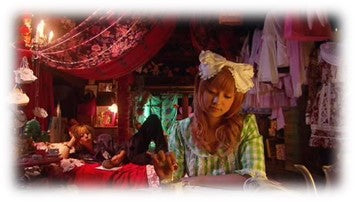
Media representation and its development of personal tools for defending our choice to wear EGL: Part I – ANTM and Kamikaze Girls
Katherine RoseShare
Written by Lucy May
(Disclaimer: This is a mixture between a research article and an opinion piece, and therefore understandably may not be something all readers will 100% agree with)
It is profoundly difficult to appear different in a world that demands us to all be the same and confirm to certain standards or aesthetics of being. Even in a world where there is more representation of non-traditionally normative lifestyles and subcultures in the media than ever, it is still hard to live a life in which we look a way that is different from those around us: especially if looking different is a choice we have personally made. As fanciers and wearers of EGL fashion, we are acutely aware of this fact. The jeers and intolerance of those who see us as ‘other’, even in 2020, are ever present. There are still relatively few pieces of media that truly work to help explain and describe the fashion that we love. That is why we have decided to dedicate a couple of blog posts here at R.R. Memorandum to discussing some immensely powerful EGL-based media.
I wonder if you remember when your first encounter with EGL fashion was? Do you remember what it meant to you? Mine was through something that most people my age probably grew up with. A television programme called America’s Next Top Model (or ANTM). It probably was yours, too…and you just don’t remember. I actually didn’t remember until my friend Ophelia reminded me about it during one of our spirited discussions about the niche media for which we have a shared affinity. Ophelia was able to remind me, however…and when I went back and watched, it all came rushing into my mind: a residual memory, brought back to the forefront. A reminder of my own EGL Genesis moment that I had managed somehow to forget had happened.
In the third cycle of the long-running reality show, the models went for their abroad trip to Tokyo, Japan. The year was 2004, right at the time popular Japanese lolita brands were starting to produce printed main pieces that weren’t merely gobelin florals and checks. In the first screenshot, we see the first lolita that I, and perhaps you, might have ever seen (but not really remembered that you’d seen). For me, even now, this person is the embodiment of everything I love about lolita fashion: the shape, the modesty, the sense of quiet confidence and poise. The rebellion. Even among the other styles presented to the models, she is the one who stands out, which to me represents the true meaning of Harajuku fashion. (Please excuse the potato quality of the provided screenshots – they are the best I could provide.)

And maybe this was your first time seeing inside a lolita shop:


Re-watching this episode (the 12th in cycle 3, I believe), I struggled so much with the overwhelming urge to scream, largely owing to the model’s attitudes as outsiders towards this unique fashion and these beautiful clothes (many of which are now so difficult to find and probably are not documented online, owing to the absence of Hello Lace!), not to mention how the show did not really go into much detail about the significance of the style before sending the girls out to try to recreate it. However, the agent introducing the girls to the fashion is very positive, stating that the wearer is ‘amazing’. In a V.T response to this, one of the models implies the lolita had not looked in the mirror before leaving the house that morning, indicating a distain for a self-expression not predicated on thoughts from external sources. This is the exact opposite of what lolita fashion is all about.
At the time, I probably did not think much about the behaviour of the models. However, after watching the episode and looking at the screenshots, I find it difficult not to think that the models themselves are the ones who look out of place and ridiculous, and humiliate themselves by reacting the way they do to their first exposure to the fashion. This is a feeling, in time, I’ve grown to have for those who take pictures of us on the street without our permission, or generally do or say disrespectful things because they are jarred by the moment of culture shock our fashion brings to that moment in their lives. I often feel sad that the person cannot look beyond themselves to understand the differences of others, or what clothes they may find amusing might mean to the person wearing them. When someone disrespects a lolita for their clothes, it is a truly personal attack to that lolita. Especially if we look at lolita from Momoko’s perspective.

Possibly the most important piece of early EGL media is the film based on the light novel, Shimotsuma Monogatari – Kamikaze Girls. Coincidentally released in the same year as the discussed episode of ANTM, Kamikaze Girls was the first piece of media that properly educated us on lolita fashion, explaining it so well to so many of us that we decided to begin wearing it ourselves. The lifestyle Momoko wants to lead offers something pure, simple and uncomplex. She proudly wears her Baby the Stars Shine Bright apparel (admittedly rather ill-got gains) like armour, actualising a self that can function in a world that is so unlike her inner reality. She hyper-fixates upon her passion for the clothes she loves, and is eventually able to use this passion to help others around her: helping Ichigo and the designer at BTSSB through use of her embroidery skills which she learnt through love of rococo/lolita lifestyle and necessity of fixing her clothes when they become moth-eaten. She is only able to help others through being and expressing her truth self through wearing and loving her Baby the Stars Shine Bright clothing. For us here at R.R. Memorandum, Momoko’s stalwart striving for self-shrouding in frills, for collection, for contentment outside of social expectation, and for personal control lends to a sense of neurodiversity within the character which, while obviously not deliberately written, speaks to us (as afab auties).

This sensibility is furthered when she explains that it is in reaching for that which makes us feel happy, content and saves us from indifference does not need to be as complicated as a romantic relationship. This perhaps even lends to an ace sensibility – which is something I know that many in the EGL community can relate to (and which can be especially annoying when people hear the name ‘lolita’ and absurdly assume the fashion is something to do with a kink, when in fact the wearer has reached for it as a means to express a sense of modesty and positionality outside of any sort of sexual gaze). As the main protagonist, Momoko never engages in a romantic or sexual relationship throughout the film, nor refers to a desire to be in one. This is profoundly important. Her message is that you can fall in love with your own independence and sense of self through indulging in what you love. I think we can all agree there is a certain indulgence that we afford to ourselves when we choose to collect and wear EGL. But it also takes courage to be this way. It’s special to us, empowering…life-changing. Something to celebrate and uplift ourselves in this world that so often is determined to bring us down in its own special way (depending on who we are demographically). Furthermore, as a lone lolita, Momoko is a bit of an oddity to those of us who run in packs, or communities. However, this is where the beauty of the film lies. Momoko believes she does not need anyone else to be happy. She is content in herself and in her world. I think there is a lot to be said for being content being yourself when no one else around you is the same as you are. That is what is so inspiring about the lolita(s) in that episode of America’s Next Top Model, too.

I think the journey that Ichigo goes on within Kamikaze Girls is that which we ourselves go through when we are first learning about lolita fashion. Many of us in this fashion, even before we were lolitas, felt like outsiders. Maybe we worn another niche fashion, or simply felt like there was nowhere we quite belonged, and so we tried to conform aesthetically to make it easier to connect with others around us. Ichigo, though a fellow social outsider owing to her involvement in a gang, is at first extremely dissimilar to Momoko in her dependency of others for approval. It is only really through Momoko that she realises that happiness must come through making decisions about the life you want to lead for yourself, which ultimately leads her to a decision to leave the gang in order gain independence. While, ultimately, Ichigo ends up falling into similar social traps after she makes this decision, it does not take away from the growth that, through Momoko, she has had.
I think that it’s the moral of these two piece of media (ANTM and Kamikaze Girls): that you should, as person who wears EGL, feel empowered by your decision to do so, and ignore the critics who are determined to misunderstand you. Your life is yours to live and dress as you please. As Momoko herself would say: if it makes you happy, do it.

1 comment
This is something I needed to see today. Having a lot of issues with feeling like I don’t really want to wear the fashion anymore because of what my normie think, but this has convinced me to keep going because it makes me really confident in myself.